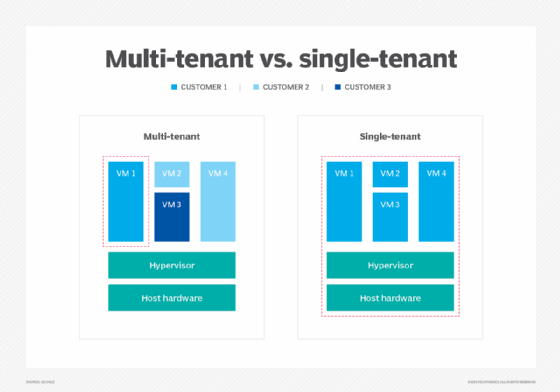
Getty Images
Single-tenant vs. multi-tenant cloud architecture
Single-tenant and multi-tenant cloud architecture offer unique advantages and disadvantages. Understanding both is crucial for selecting the best fit for your organization.
Single-tenant and multi-tenant cloud architecture provide different environments for deploying and managing software and storage. Understand an organization's need for security, hardware and scalability to determine if a shared or standalone environment is best.
Let's examine the pros and cons of single-tenant and multi-tenant cloud architecture and which industry is best for each environment.
What is single-tenant architecture?
Single-tenancy is architecture where a single software application and its supporting infrastructure serve one customer. It's commonly implemented in a SaaS delivery model or as a cloud service.
Each customer or tenant has a dedicated server, environment or software application only for them. They also have dedicated hardware and networking resources. The provider helps manage the hardware and related software, while the tenant has control over customization and use.
What is multi-tenant architecture?
Multi-tenancy is architecture where a single software application serves multiple customers on shared hardware. Multiple instances of the software operate in a shared environment, so each tenant is integrated physically.
Software and related data do not cross between tenants, even though they share the same infrastructure. Each tenant uses dedicated software in data centers but shares hardware and networking resources across the facility.

Pros of single-tenant and multi-tenant architecture
Each architecture has advantages, making it essential for organizations to align their choice with specific needs and operational goals.
Single-tenant
Administrators usually choose single-tenant cloud architecture for security enhancement. Data and systems are isolated from other tenants, which minimizes the risk of cyberattacks. Single-tenant architecture is ideal for industries with strict compliance requirements, such as finance, healthcare and government.
Tenants can customize software and hardware to meet company needs without compatibility complications with other tenants. There is also more flexibility in setting up workflows and integrations.
Single-tenant architecture offers enhanced performance and dependability as resources -- both people and equipment -- are available anytime. This guarantees consistent performance based on the chosen infrastructure and setup.
Multi-tenant
Multi-tenant architecture is budget-friendly, as costs are distributed across tenants. This architecture is best for smaller companies and those trying new technologies or approaches. Providers and data center owners can offer tenants competitive pricing without compromising technology quality.
Multi-tenancy offers infrastructure scalability to accommodate more users without significant additional costs to tenants. Businesses can grow without the need to manage hardware or demand, as the facility owner is responsible for management.
The data center facility owner manages all maintenance tasks in multi-tenancy, leaving customers free to focus on their core business. Tenants have access to the latest features and security enhancements without the added overhead costs. The underlying infrastructure is set up more efficiently to maximize the use of hardware and network resources across the architecture.
Cons of single-tenant and multi-tenant architecture
While both cloud architecture types are beneficial, some drawbacks might cause IT teams to hesitate before signing on the dotted line.
Single-tenant
Single-tenant architecture has higher costs because of the hardware and network resources required and the technical staff needed to manage them. Staff training, onboarding costs, maintenance scheduling and hardware lifecycles must also be managed and considered.
It also may require complex management work if it integrates with on-premises and cloud systems elsewhere. Each integration point increases the complexity, time and cost of single-tenant architecture. It also tends to have underutilized resources because of improper setup, maintenance or integration. In these cases, dedicated resources sit idle, while costing the same as a highly used environment.
Multi-tenant
The shared environment of multi-tenant architecture adds an element of risk, even while data and apps are logically isolated. Multi-tenant security risks cause industries like healthcare, finance and government to choose single-tenant architecture.
Tenants are limited in what they can customize in a multi-tenant data center, increasing compatibility concerns with other systems. Organizations also depend on the provider's maintenance schedule, which might not align with their operational timelines.
When to choose single-tenant and multi-tenant architecture
Choosing between single-tenant and multi-tenant architecture depends on each business's uses. Large enterprises might think multi-tenant architecture is more attractive and cost-effective until they realize they need more customization and integration features. So, they decide on single-tenant architecture.
Multi-tenancy is a good option for startups and other cost-conscious businesses as they start and grow. However, if they grow faster than the data center facility can scale, they might struggle with performance complications and bottlenecks.
Deciding on architecture depends on what a business considers an advantage and what best suits its situation. Before choosing architecture, consider the following lists.
Choose single-tenant architecture if an organization needs the following:
- High scalability.
- Specific backup and recovery service-level agreements.
- Full control over the data and network.
- No shared infrastructure or effects from noisy neighbors.
- High customization and/or support for nonstandard applications or workflows.
- Isolated data residency and separation for regulated industries or handling privileged data.
Choose multi-tenant architecture if an organization needs the following:
- Quick, easy and affordable onboarding.
- Highly scalable infrastructure with low costs.
- Low ongoing maintenance costs, upgrades and fixes.
- Advanced threat detection from the latest security information and event management tools.
Julia Borgini is a freelance technical copywriter, content marketer, content strategist and geek. She writes about B2B tech, SaaS, DevOps, the cloud and other tech topics.








